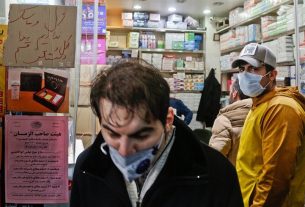Mon 03 February 2020:
The death toll in China from the deadly coronavirus outbreak that originated in the central city of Wuhan, rose to at least 361 on Monday, as the Philippines became the first country outside China to confirm a death from the infection.
The National Health Commission said there were 57 new fatalities on Sunday, all but one of them in Hubei, which has been effectively sealed off from the rest of the country for more than a week.
The total deaths nationwide was at least 361, with 17,205 people across the country infected with the virus, after 2,829 new cases reported.
– China stocks crash –
Chinese stocks crashed on Monday with some major shares quickly falling by the maximum daily limit as the country’s investors got their first chance in more than a week to react to the spiralling coronavirus outbreak.
The benchmark Shanghai Composite Index dived 8.73 percent, or 259.83 points, to open at 2,716.70.
The Shenzhen Composite Index, which tracks stocks on China’s second exchange, sank 8.99 percent, or 158.02 points, to 1,598.80.
The scale of the plunge was remarkable even by the standards of China’s notoriously volatile share markets, indicating deep concern over the viral outbreak’s economic impact.
The yuan also weakened by nearly 1.5 percent to around 7.00 to the dollar.
But in Hong Kong, the benchmark Hang Seng Index edged up 0.17 percent, or 43.59 points, to 26,356.22 in the first few minutes.
Markets in the world’s second-biggest economy had closed on January 24 for the annual Lunar New Year holiday, but since then the viral epidemic that started in Wuhan has spread around the world.
Global concern has dragged down stocks and major corporate names have frozen or scaled back their Chinese operations, threatening the global supply chain as so many of the world’s products are manufactured in China.
– ‘Large’ economic impact –
China’s central bank said Sunday it would pump 1.2 trillion yuan ($173 billion) into the economy on Monday to help limit market losses.
“Investors will release their emotions at first and then make further decisions based on the epidemic situation and the potential stimulus measures rolled out by the government,” Zhang Qi, an analyst with Haitong Securities, said before the open.
“Whether the spread of the epidemic is effectively contained, and how much of a toll it takes on the economy are stressful for investors.”
Travel and tourism shares plummeted after China curbed domestic travel to slow the virus and a growing list of foreign countries and airlines halted or reduced travel links with China.
China International Travel Service quickly fell by the maximum 10 percent allowed, to 73.80 yuan.
Individual Chinese stocks are limited to a 10 percent daily move in either direction to limit volatility, after which trading in those shares is suspended.
Foxconn Industrial Internet, an arm of Taiwanese tech giant Foxconn, also fell by the daily limit to 18.00 yuan.
Foxconn had said last week it is keeping its Chinese factories closed until mid-February, potentially affecting global supply chains for tech companies that rely on it for everything from Apple’s iPhones to flat-screen TVs and laptops.
Markets had been scheduled to re-open on Friday after the week-long Lunar New Year holiday, but that was extended by the government to buy time in the fight against the virus.
Consumer bellwether Kweichou Moutai, the world’s largest distiller and whose fiery liquor is a favoured Lunar New Year gift, fell 4.26 percent to 1,007.99 yuan.
The People’s Bank of China (PBOC) said its market intervention was aimed at maintaining “reasonable and abundant liquidity” in the banking system, as well as a stable currency market, during the epidemic.
China’s economy is expected to take a clear hit from the crisis, which has brought industrial regions grinding to a halt.
“The near-term impact on Chinese GDP growth is likely to be large,” Oxford Economics said in a research note.
“Considering the affected areas account for just over 50 percent of total Chinese output, we think this could lead China’s annual GDP growth to slow to just four percent in Q1,” it added — down from a previous forecast of six percent growth.
Think your friends would be interested? Share this story!





